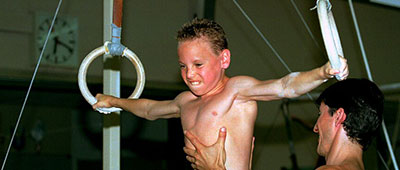312212 - Assessment of muscle activity in different exercises used to achieve the iron cross. Comparison between achievers and non-achievers
| When |
Oct 14, 2023
from 11:45 AM to 12:30 PM |
|---|---|
| Where | Conference room 4 |
| Attendees |
MAG's coaches and gymnasts |
| Add event to calendar |
|

We verified training the iron cross (IC) with assistive devices (herdos; H0) and added external load (HL) to equate the moments of force developed in the rings (R0) could be considered as an intermediate step between the no-overloaded herdos situation (H0) and the IC performed in R0. The sEMG activity levels measured in the present study were normalized with respect to a standing IC before comparing gymnasts who can perform the IC in R0 (achievers) and gymnast who do not (non-achievers) in the two herdos conditions (H0 and HL). Seven muscles were chosen for sEMG analysis: Pectoralis Major (PM), Latissimus Dorsi, Teres Major (TM), Lower Trapezius, Serratus Anterior, Biceps Brachii (BB), and Triceps Brachii (TB). Additionally, three indices were calculated to measure levels of coactivation: Elbowidx, Scapulaidx and Shoulderidx. As main results we can highlight that: 1) The bigger differences in sEMG activity among situations were found for the PM and BB. 2) Non-achievers activated their musculature to a greater extent than the achievers independently of the herdos situation. 3) Achievers’ Elbowidx was the only index that was significantly higher in the R0 in comparison to HL and H0. As “take home messages”: 1) sEMG activity of PM and BB was particularly sensitive between situations, independently of the level of achievement. 2) We recommend training the IC by adding external load in herdos situation to increase muscle activity to levels closer to the rings’ situation but avoiding potential factors of injuries.
The aim: Having some experience related to the physical conditionning oriented to rings routine


